Hyundai i10 Review 2025
Hyundai i10 At A Glance
All versions of the Hyundai i10 are easy to drive, cheap to run and backed by a comprehensive five-year unlimited-mileage warranty. The Hyundai i10 is also bigger than the average city car, meaning more interior space and a bigger boot. But what makes it stand out is its blend of comfort and handling. True, the i10 might not be quite as much fun to drive as the Volkswagen Up, but it makes a compelling case for the best city car on the market. Read our Hyundai i10 review to find out more.
It might not surprise you to learn that the Hyundai i10 is one of the best city cars on the market. Thing is, that's not hard when it's one of the only city cars on the market.
Why? Well, most rival manufacturers have given up on the city car class these days. Such small cars don't tend to make their makers enough profit, so many have withdrawn their city car offerings in order to concentrate their manufacturing efforts on more profitable models. That's why, in the present new car market, there are only a handful of city car offerings left.
However, the Hyundai's status as one of the best city cars hasn't merely happened by default. You see, even before this all happened and there were lots of different city car choices, the Hyundai i10 was still one of the best.
Why? Well, several reasons. For starters, it's one of the roomiest cars in the class, with enough room in the rear seats for a pair of adults and one of the largest boots in the class. The interior is also solidly built, comfortable, pleasant to sit in, and well-equipped (especially in later examples).
Another thing that makes the i10 stand out is its civilised driving experience. It combines alert handling and easy controls with an impressively comfortable ride, and the teeny entry-level 1.0-litre engine punches well above its weight, and this all conspires to deliver a sophisticated and grown-up on-road feel.
It's no longer the bargain-basement car it once was, but it's still very affordable, and the shortage of similarly small competitors means that it's still one of the cheapest new cars that money can buy, and it's even better value as a used car. And whether you're buying used or new, the deal is still sweetened by Hyundai's impressive reliability record and generous five-year, unlimited-mileage warranty.
Hyundai i10 handling and engines
- Engines range from 1.0 63 AMT to 1.2 MPI
- Readers report Real MPG to be between 41–55 mpg
Hyundai i10 2025: Handling and ride quality
The Hyundai i10 is designed for the city and its responsive steering and good visibility mean it’s ideal in urban environments. You can easily get it into a small parking space and it’s a doddle to manoeuvre around a multi storey.
Motorway travel is an area where the i10 really excels, with wind noise and vibration kept to a minimum. The steering is light and lacking in feel below 50mph, but it develops a bit of feedback at motorway speeds and this makes it easy to build confidence with the i10.
Regardless of which engine you choose, the i10 is comfortable to drive. The supple suspension does a good job of controlling body movement when cornering, and most lumps and bumps are absorbed with ease on 14- and 15-inch wheels. Admittedly, things get a little more bumpy on 16-inch wheels, but the i10 remains on the comfortable side of firm on all but the roughest of roads. It’s this impressive combination of ride and handling that makes the i10 so attractive.
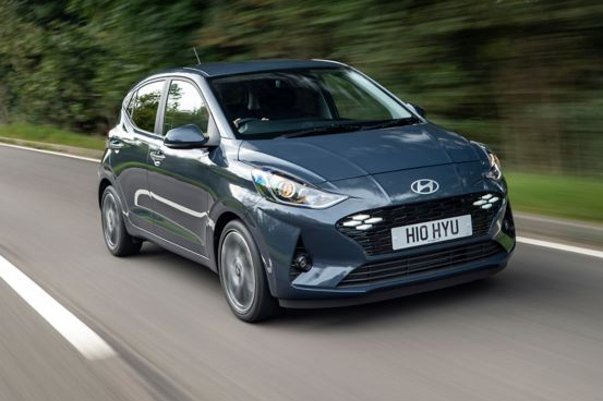
Hyundai i10 2025: Engines
There are only three engines to choose from with the Hyundai i10, both petrols, with the star performer being the excellent 1.0-litre three-cylinder unit.
It might not sound all that capable on paper, with 67PS and 0-62mph taking almost 15 seconds, but on the road it is actually very good, with low levels of noise and lots of low-gear pull. Unusually for a small engine, it is adept for pulling the i10 along in a high gear at low revs.
The next rung on the ladder, the 1.2 petrol, gets an extra cylinder to develop 84PS and 118Nm of torque. However, despite its power boost, the 1.2 struggles with hills and overtaking.
The i10 gets a five-speed gearbox as standard, which works extremely well. A five-speed automated manual is the only automatic option, and it's available with both the 1.0 and 1.2 engines, but we wouldn't recommend it. It’s extremely crude, with poor anticipation that produces lots of unnecessary gear changes and body vibration.
The other engine choice is a turbocharged version of the 1.0-litre engine, available only with a five-speed manual transmission. Itt's by far the quickest version of the i10, doing the 0-62mph dash in 10.5 seconds, but we haven't tried it yet, so we can't teel you how it feels.
Hyundai i10 2025: Safety
All versions of the Hyundai i10 get automatic (halogen) headlights and high beam assist that dips the beam when oncoming vehicles are detected.
Cruise control is also fitted as standard, along with a comprehensive package of safety tech that prevents the i10 from straying out of its motorway lane. It will also automatically apply the brakes, if the system thinks an impact is imminent, or urge the driver to take a break if it detects poor driving caused by fatigue.
Despite this level of safety kit, the i10 has only been awarded three stars in Euro NCAP crash tests.
Hyundai i10 2025: Towing
Unsurprisingly, the Hyundai i10 is not a car designed for towing. It's intentionally very small and light, and as a result, it's only rated to pull just 300kg, regardless of whether your trailer is braked or not. It'll just about pull the skin off a rice pudding, then, but not much more.
| Engine | MPG | 0-62 | CO2 |
|---|---|---|---|
| 1.0 MPI | - | 14.6–17.3 s | 114–126 g/km |
| 1.0 T-GDi | - | 10.5 s | 123 g/km |
| 1.2 MPI | - | 12.6–15.8 s | 124–130 g/km |
Hyundai i10 interior
- Boot space is 252–1050 litres
| Dimensions | |
|---|---|
| Length | 3670 mm |
| Width | 1961 mm |
| Height | 1480 mm |
| Wheelbase | 2425 mm |
Hyundai i10 2025: Practicality
With a boot volume of 252 litres, the Hyundai i10 has enough space to carry two large suitcases or the weekly shop. The rear seats also have a 60/40 split and can easily be lowered, but do not fold completely flat.
The high boot lip and narrow opening also makes it a little awkward to make the most of the i10's bootspace, but the maximum boot capacity isn’t too far short of the class leaders. However, there’s no adjustable boot floor so you do have to lean in to lift out heavy objects.
There’s good storage, with decent sized door pockets and a couple of cupholders by the gear lever, while the glovebox is actually big enough to be useful. What really makes the Hyundai i10 stand out against the average city car is its extra space, most notably in the back. It means more room, not just for adults, but crucially, for child car seats and children’s legs.
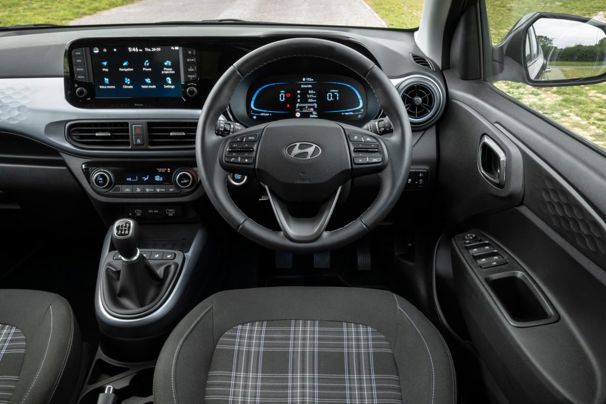
Hyundai i10 2025: Quality and finish
In-keeping with its value-focus, the Hyundai i10 is only offered with cloth seats. However, while the dull coloured fabrics might not look particularly impressive to the eye, the seats are extremely comfortable with firm padding and a wide base that supports the lower back and upper leg muscles.
Like its small car rivals, the cabin of the i10 is covered in hard plastics. These are hardwearing and easy to clean, but also manage to look reasonably good. It certainly doesn’t feel cheap. There are some nice touches and most versions get an attractive touchscreen infotainment system.
Hyundai i10 2025: Infotainment
The old SE models came with a black and white radio display, which does the job but looks very ‘hire car’. The other trims, from SE Connect upwards, had a much better looking 8.0-inch touchscreen. Later on, the touchscreen system was made standard throughout the range.
The system is not quite as well laid out as the infotainment in a Volkswagen, but it is easy to use and has Apple CarPlay and Android Auto, which makes it simple to pair a smartphone for music, maps and navigation.
Thankfully, operating the heating and air conditioning controls is easy, with Hyundai retaining traditional buttons and dials, located under the touchscreen. An additional row of buttons next to the gear stick operate the heated steering wheel and seats, where fitted.
Hyundai i10 value for money
Hyundai i10 2025: Prices
The Hyundai i10 is no longer the bargain-basement car it once was, but the fact that many rival manufacturers have withdrawn their city car offerings because they don't make enough profit on them means that the i10 is still among one of the most affordable new cars you can buy.
Brand new prices start at around £15,000, which gets you the well-equipped entry-level trim with the excellent 1.0-litre engine. The upgrade to Premium trim does get you some very desirable items of kit, but adds around £1300 to the price. You'll make your own judgement on whether or not it's worth it. Prices rise to more than £18,000 at the top of the range.
Of course, you can save more by buying a used example, and Hyundai's excellent warranty means that most i10s of this generation will likely still have some cover left for extra peace of mind. A budget of £11,000 will get you a vast choice of examples, a mixture of 1.0-litre and 1.2-litre engines paired with various different trims, with around three years and between 20,000 miles and 40,000 miles on the clock.
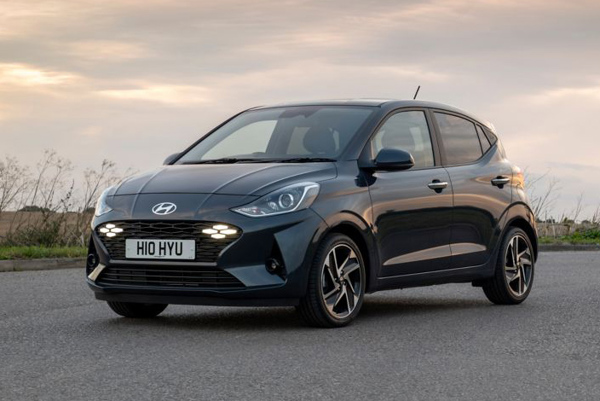
Hyundai i10 2025: Running Costs
All engines are easy on fuel and will prove cheap to run. Of the early exampes, the most economical model in the range according to the official WLTP figures is the 1.0-litre MPi SE Connect. The claimed figure is 56.5mpg and you should see at least 50mpg in the ral world. That’s the going rate for all manual models (the figures vary depending on trim).
Opt for the automatic and this drops to the mid 40s. Another reason not to choose it.
Later on when the car was updated, mpg figures dropped slightly, probably due to the weight of the extra kit the car was carrying. The 1.0 manual was still the cleanest, doing up to 55.3mpg, while the 1.2 wasn't far behind on 53.3mpg, with the 1.0 turbo a little further back on 52.3mpg. The auto-equipped models became a bit more efficient, though, with figures of 52.3mpg for the 1.0 and 51.4mpg for the 1.2.
Some versions of the i10 (all of them fitted with the automatic gearbox) fall into insurance group 1, making these versions highly coveted by young drivers due to the relatively low premiums they command. The priciest i10s on insurance fall into group 10, so no version will break the bank.
In terms of long-term reliability, there’s every reason to have plenty of confidence in the i10. Hyundai has a strong track record for durability and we get very few readers reporting problems. Plus, of course, the car comes with Hyundai’s five-year warranty. This may not match the seven years of Kia, but there is no mileage limit.
Satisfaction Index
 What is your car like to live with?
What is your car like to live with?
We need your help with our latest Satisfaction Index, so that we can help others make a smarter car buying decision. What's it like to live with your car? Love it? Loath it? We want to know. Let us know about your car - it will only take a few minutes and you could be helping thousands of others.
Help us with the Honest John Satisfaction Index nowHyundai i10 models and specs
When it first went on sale, the i10 was available in SE, SE Connect and Premium trim levels
The entry-level Hyundai i10 SE came with all the essentials like:
- air-conditioning
- DAB radio
- Bluetooth
- leather steering wheel and gear lever
- steel wheels
However, we’d suggest the Hyundai i10 SE Connect was the best model in the range. This has:
- 15-inch alloys
- 8.0-inch touchscreen
- rearview camera
The top model was the Hyundai i10 Premium, which looked quite pricey when new. However, it did come really well equipped with luxuries such as:
- heated seats
- heated steering wheel
Later on, the trim levels available were changed to Advance, Premium and N Line, and spec levels rose across the board. The new entry-level Hyundai i10 Advance trim comes with:
- 15-inch alloy wheels
- front- and rear electric windows
- leather steering wheel and gearknob
- manual air-conditioning
- cruise control
- heating and power adjustment for the door mirrors
- rear parking sensors
- reversing camera
- 8.0-touchscreen display with smartphone integration
- Bluetooth
- four speakers
Next up is the Hyundai i10 Premium, which adds:
- 16-inch alloy wheels
- power folding door mirrors
- blue ambient lighting
- heated front seats
- climate control air-conditioning
- front foglights
- rear privacy glass
- keyless entry and start
- wireless phone charging pad
At the top of the range sits the Hyundai i10 N Line, which adds sporty styling touches inside and out, but pretty much nothing else.
| Dimensions | |
|---|---|
| Length | 3670 mm |
| Width | 1961 mm |
| Height | 1480 mm |
| Wheelbase | 2425 mm |
| Miscellaneous | |
|---|---|
| Kerb Weight | 993–1045 kg |
| Boot Space | 252–1050 L |
| Warranty | 5 years / Unlimited miles |
| Servicing | 12000 miles |
| Costs | |
|---|---|
| List Price | £14,590–£18,855 |
| Insurance Groups | - |
| Road Tax Bands | C–D |
| Official MPG | - |
| Euro NCAP Safety Ratings | |
|---|---|
| Adult | - |
| Child | - |
| Pedestrian | - |
| Overall | - |
Currently on sale
| Hatchback | |||
|---|---|---|---|
| Version | List Price | MPG | 0-62 |
| 1.0 MPI 67ps Premium 5dr | £14,590 | - | 14.6 s |
| 1.0 MPI 67ps Premium Auto 5dr | £16,550 | - | 17.3 s |
| 1.2 MPI 84ps Premium 5dr | £16,850 | - | 12.6 s |
| 1.2 MPI 84ps Premium Auto 5dr | £17,350 | - | 15.8 s |
| Advance 63 MPi AMT Auto Start/Stop 5dr | - | - | - |
| Advance 63 MPi Start/Stop 5dr | - | - | - |
| Advance 67 MPi AMT Auto Start/Stop 5dr | £16,405 | - | - |
| Advance 67 MPi Start/Stop 5dr | £15,755 | - | - |
| Advance 79 MPi AMT Auto Start/Stop 5dr | £17,555 | - | - |
| Advance 79 MPi Start/Stop 5dr | £16,555 | - | - |
| Advance 84 MPi AMT Auto Start/Stop 5dr | £16,605 | - | - |
| Advance 84 MPi Start/Stop 5dr | £15,955 | - | - |
| N Line T-GDi 100 Start/Stop 5dr | £15,965 | - | 10.5 s |
| N Line T-GDi 90 Start/Stop 5dr | £18,355 | - | - |
| Premium 63 MPi AMT Auto Start/Stop 5dr | £18,055 | - | - |
| Premium 63 MPi Start/Stop 5dr | £17,055 | - | - |
| Premium 79 MPi AMT Auto Start/Stop 5dr | £18,855 | - | - |
| Premium 79 MPi Start/Stop 5dr | £17,855 | - | - |
On sale until June 2023
| Hatchback | |||
|---|---|---|---|
| Version | List Price | MPG | 0-62 |
| 1.0 MPI 67ps SE Connect 5dr | - | - | 14.6 s |
| 1.0 MPI 67ps SE Connect Auto 5dr | - | - | 17.3 s |
| 1.2 MPI 84ps SE Connect 5dr | - | - | 12.6 s |
| 1.2 MPI 84ps SE Connect Auto 5dr | - | - | 15.8 s |
On sale until April 2023
| Hatchback | |||
|---|---|---|---|
| Version | List Price | MPG | 0-62 |
| 1.0 MPI 67ps SE 5dr | - | - | 14.6 s |
Model History
- September 2019: Hyundai i10 revealed
- September 2019: Hyundai i10 N-Line announced
- December 2019: Hyundai i10 prices and specifications confirmed
- July 2020: Hyundai i10 N Line priced from £16,195
September 2019
Hyundai i10 revealed
The new Hyundai i10 has made its debut ahead of its official reveal at the 2019 Frankfurt Motor Show.
With a lower roof and wider body than its predecessor, Hyundai says the i10 has a 'young and dynamic design'. Customers can choose from 10 exterior colours including three new ones: Dragon Red, Brass and Aqua Torquoise. Buyers will also be given the option of a two-tone roof in either Black or Red.
The interior offers four different interior colour combinations as well as more space, thanks to an increased wheelbase compared to its predecessor. There's a 252-litre boot which is easily accessed thanks to a lip that's been lowered by 29mm. The rear seats can also be dropped using one hand.
There's a host of new connectivity features, allowing drivers to locate their car using an app on their phone, as well as send points of interest to the car's in-built navigation system. The car will also be available with Apple CarPlay and Android Auto, as well as wireless phone charging.
The new i10 will be available at launch with two engines: a 1.0-litre MPi three-cylinder petrol with 67PS and 96Nm torque, as well as a 1.2-litre MPi four-cylinder with 84PS and 118Nm torque.
Both engines are available with two transmission choices, which consist of a five-gear manual transmission and a five-gear automated manual transmission - a replacement for the traditional auto gearbox used in the old model.
September 2019
Hyundai i10 N-Line announced
Following the recent unveiling of the new i10, Hyundai has announced a sporty N-Line model, set to go on sale in Europe next summer.
Exterior design enhancements include redesigned bumpers and grille, along with exclusive 16-inch alloy wheels and LED Daytime running lights. Other exclusive design features include the N Line emblem, i10 sign in red font, as well as a skid plate and diffuser. Customers can also choose from a total of six exterior colours which can be combined with a two tone roof.
Inside, the i10 N-Line features an N-branded steering wheel and gear shift lever, as well as red air vent rings and metal pedals. Meanwhile, the sporty seats offer more support for performance-oriented driving precision.
The i10 N Line offers an exclusive 1.0-litre T-GDi 3-cylinder with 100PS and 172Nm torque. This is in addition to the 1.2-litre MPi 4-cylinder with 84PS and 118Nm torque. Both engines are available with a five-gear manual transmission.
December 2019
Hyundai i10 prices and specifications confirmed
Hyundai has announced the pricing and specification of the new i1 ahead of it going on sale on the 18th January.
Going into its third generation, Hyundai says the new i10 will offer a comprehensive upgrade over previous models, with a substantial make over in exterior and interior design, equipment and driving dynamics. A brand new car from the ground up, the new i10 will reposition the model within the A segment and will offer many USP’s against its competitors with a focus on technology, segment leading connectivity and safety features and a full five-seat configuration.
Exterior design has evolved from the previous generation, with the i10’s dynamic and sleek design offering a contrast between its soft surfaces and sharp lines. Compared to its predecessor, the new i10 has enhanced proportions, with its visual stance improved by a lowered roof (20mm), wider body (20mm) and longer wheelbase (40mm). These enhancements can be complemented by newly-designed optional 16-inch alloy wheels.
All new i10's interior design further demonstrates the repositioning of the model when compared to the previous generation, without losing any of the i10’s reputation for real world convenience and usability. The entry level S specification of the previous model is now no longer available; with customers now enjoying the increased specification of SE trim at the starting point of the new i10 range.
The i10 SE 1.0 MPi 67PS 5 speed manual is available from £12,495. Standard equipment includes DAB radio with 3.8-inch display, Bluetooth, air conditioning, electric windows, leather steering wheel and gear lever, electric mirror adjustment and cruise control. Standard safety equipment includes Lane Keep Assist (LKA), Driver Attention Alert (DAA), High Beam Assist (HBA) and Forward Collision Warning System (FCWS) with integrated Autonomous Emergency Braking (AEB), Lane Departure Warning System with Lane Keep Assist (LKAS) and eCall, which can automatically dial emergency services in the event of a serious accident, shortening response times and improving post-accident protection.
The i10 SE Connect trim starts at £13,495 with the 1.0 MPi 67PS 5 speed manual. Specification enhancements over the SE include 15-inch alloy wheels, an 8-inch touchscreen display audio, rear view camera, subscription free Apple CarPlay and Android Auto, Bluetooth with voice activation and 2 rear speakers. The i10 SE Connect is also available with a 1.2 MPi 84PS four cylinder engine, with both powertrains available as a 5 speed manual, or a new 5 speed automated manual transmission.
The i10 Premium 1.0 MPi 67PS 5 speed manual starts from £14,495 and includes 16” alloy wheels, halogen bi-function headlamps with integrated position light, LED daytime running lamps, front fog lamps and privacy glass. Interior specification is further enhanced with heated front seats and steering wheel, as well as a unique to Premium honeycomb design to the dashboard, door and gear lever surround trims. The i10 Premium is also available with a 1.2 MPi 84PS four cylinder engine, with both the 5 speed manual, or new 5 speed automated manual transmission available.
Customers choosing the Premium specification can also choose the optional Tech Pack which offers a wireless charging pad for compatible handheld devices and adds an 8” touchscreen navigation with Bluelink® telematics, giving owners the ability to locate the vehicle via GPS, LIVE services and additional navigation services such as the ability to send navigation instructions via smartphone and remotely lock the vehicle. In addition to the driver convenience features, Bluelink® also serves as a convenient diagnostic tool which will notify the driver of any vehicle maintenance issues that require attention. The Tech Pack also adds the intelligent speed limit warning function that provides the driver with a visual indication of the current speed limit. The Tech Pack is a £1000 option on Premium models.
July 2020
Hyundai i10 N Line priced from £16,195
The i10 N Line introduces a number of external and internal design features influenced by the lauded i30 N, as well as chassis enhancements specific to the model. i10 N Line also introduces the 1.0 T-GDi petrol engine, offering 100PS and 172Nm of torque from only 1500rpm.
N Line styling changes over the rest of the i10 range include exterior features such as a bespoke N Line front grille with integrated LED daytime running lamps, unique design N Line 16” alloys, N Line badging to the front wings, dual chrome exhaust tips, rear LED combination lamps and red stripe finishing to the front and rear bumpers. Interior design features include N branded steering wheel and gear stick, N Line cloth seats with red stitching, rear privacy glass, black roof liner and red air vent details.
As well as styling, i10 N Line also introduces a number of powertrain and chassis changes over the standard model. These include the introduction of the 3 cylinder 1.0 T-GDi petrol engine with 100PS and 172Nm of torque, giving a 0-62 time of 10.5 seconds and a 115mph top speed. Chassis changes for i10 N Line include an increased spring rate, longer rear bump stops and new rear shock absorbers with enhanced compression control.
i10 N Line is available in a choice of 4 colours, with a no cost option solid finish and a choice of 3 pearl finishes for £550. An additional two tone finish is available for £500:

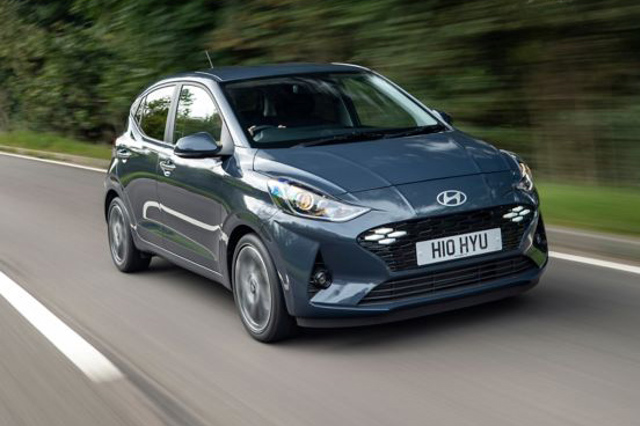
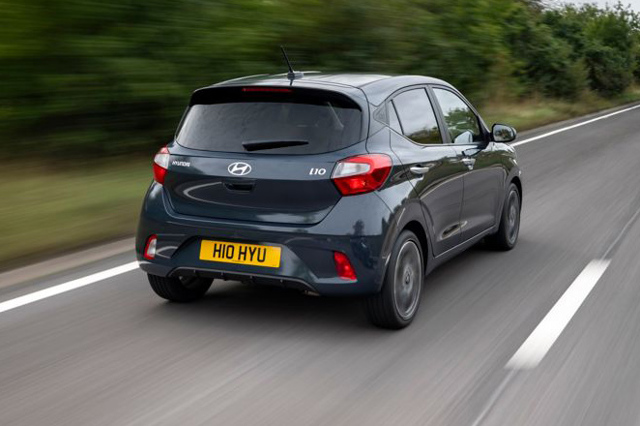
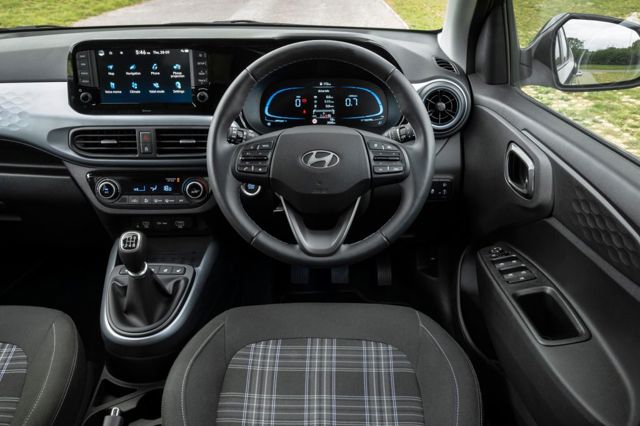
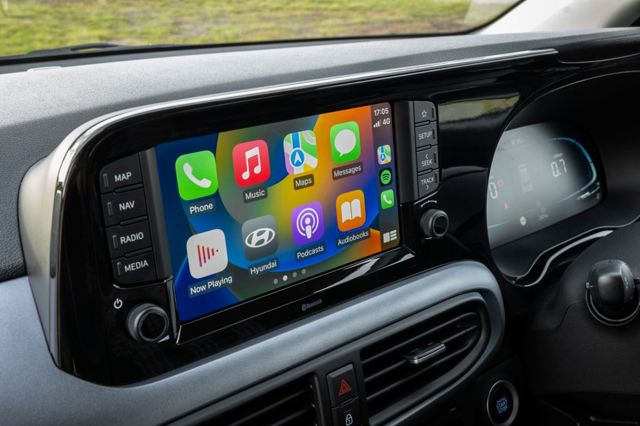
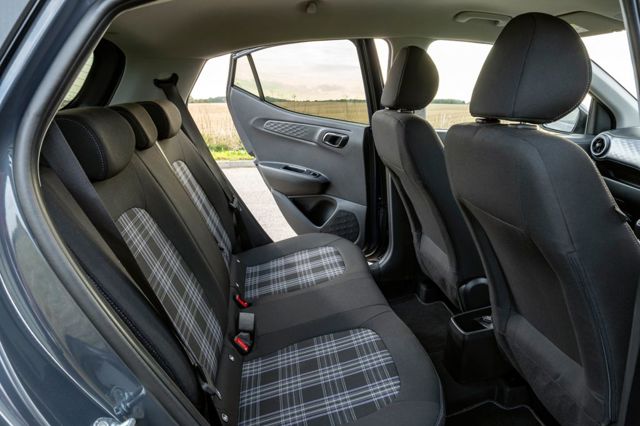
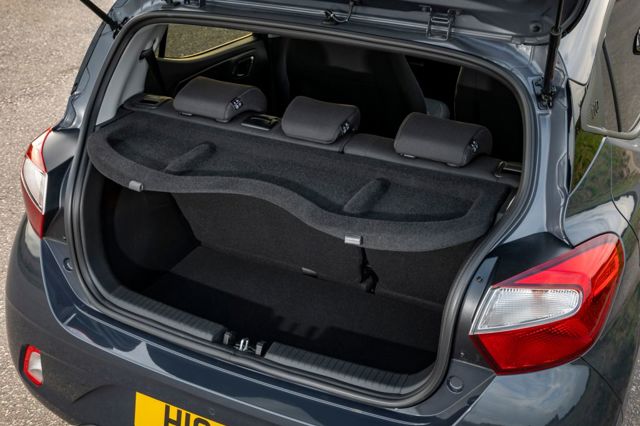

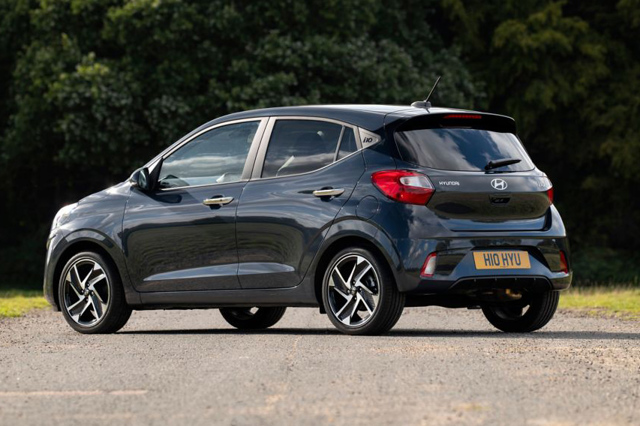
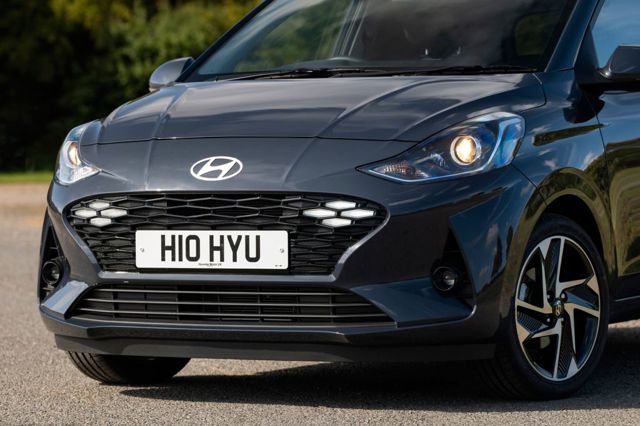


 Excellent 1.0 petrol engine, low running costs, comfortable at motorway speeds, will easily carry four adults, lots of active safety kit fitted as standard.
Excellent 1.0 petrol engine, low running costs, comfortable at motorway speeds, will easily carry four adults, lots of active safety kit fitted as standard.
 Not as good to drive as the Volkswagen Up. Crude automated manual transmission. Iffy Euro NCAP result.
Not as good to drive as the Volkswagen Up. Crude automated manual transmission. Iffy Euro NCAP result.




